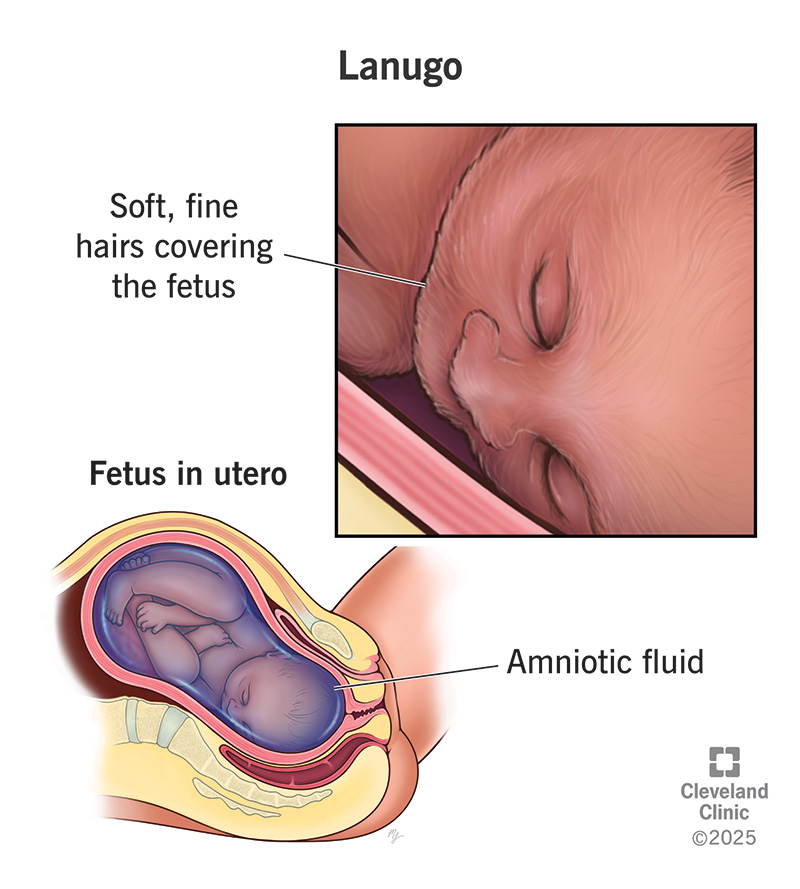Lanugo is a type of body hair a fetus develops in the uterus for protection and warmth. It usually sheds before birth. But some babies don’t shed it for several weeks after birth.
Advertisement
Cleveland Clinic is a non-profit academic medical center. Advertising on our site helps support our mission. We do not endorse non-Cleveland Clinic products or services. Policy

Lanugo is the soft, fine hair that covers a fetus in the uterus, helping to protect and warm it during fetal development. Some newborns have lanugo covering parts of their bodies at birth, especially if they’re born prematurely. Lanugo develops between 16 and 20 weeks of pregnancy. It usually sheds before birth, but some newborns may still be born with it. Lanugo disappears on its own.
Advertisement
Cleveland Clinic is a non-profit academic medical center. Advertising on our site helps support our mission. We do not endorse non-Cleveland Clinic products or services. Policy
Lanugo can also develop in people with eating disorders, teratomas (a rare type of germ cell tumor) or cancer.
Lanugo is a natural part of development. It plays a critical role in protecting a fetus and keeping it warm.
Lanugo helps vernix (the waxy, cheese-like substance that covers the fetus) stick to the skin. Vernix helps protect a fetus’s body from amniotic fluid inside the uterus. Amniotic fluid could damage the delicate skin without lanugo and vernix. When vernix is held in place by lanugo, it helps insulate the body and protect the skin. Lanugo also helps the fetus stay warm and regulates its temperature until it develops enough body fat to serve this purpose.
Lanugo also helps the fetus grow. The lanugo hair sends vibrations to fetal sensory receptors when it moves. These receptors stimulate fetal growth. When lanugo falls off, the stimulation stops, and fetal growth slows down.
Lanugo typically falls off in the last eight weeks of pregnancy. Once it’s shed from the skin, it mixes in with amniotic fluid. Because the fetus swallows amniotic fluid in the uterus, lanugo becomes part of their first poop after birth (meconium). If your baby is born with lanugo hair, it will go away on its own over time.
Advertisement
After the fetus sheds lanugo, it develops vellus hair, a fine, peach-fuzz-like hair. The vellus hair continues to help regulate temperature until adult hair (terminal hair) grows in.
Lanugo is one of the side effects of anorexia nervosa, bulimia nervosa and other eating disorders in adults. It can indicate poor nutrition and malnourishment. Healthcare providers believe lanugo grows when a person doesn’t have enough body fat to keep them warm. In response, their body grows lanugo to help insulate them.
Lanugo hair is soft, thin and feathery. If your baby is born with lanugo hair, they may look like they’re coated in a layer of delicate fur. It’s easiest to see lanugo on your baby’s back, shoulders or tailbone, but it can grow anywhere there’s a hair follicle. It doesn’t cover areas like their lips, palms, nails or soles of the feet.
Lanugo hair can range in color from very light to dark. If your baby has darker skin, lanugo may be more visible than in a baby with fair skin.
Lanugo isn’t a cause for worry when it’s seen in newborns. In children, teens or adults, severe eating disorders or malnutrition can cause lanugo. In rare cases, it’s been linked to tumors or cancer. If you’re an adult and notice lanugo on your skin or on the skin of a friend, it’s a good idea to talk to a healthcare provider.
No, it’s not bad for a newborn to have lanugo. If your baby was born premature, it’s normal for them to have lanugo hair. Full-term babies are less likely to have lanugo at birth, but it’s possible. Lanugo should fall off within a few weeks.
Treating lanugo in adults involves treating the underlying condition. In the case of anorexia, bulimia or another eating disorder, getting help to treat these conditions is the first step. Lanugo develops in people who are underweight to maintain body temperature.
If a tumor causes lanugo, your healthcare provider will typically remove the tumor. Even if the tumor isn’t cancerous, it can rupture or lead to other problems. If your tumor is cancerous, your healthcare provider may recommend additional treatment. Lanugo hair should stop growing after the tumor is gone.
Lanugo disappears within the first two months of life. But some babies may still have fine, peach-fuzz-like hair on the tops of the ears, above their tailbones or at the base of their necks. This is normal and shouldn’t be a cause for concern. If you have any questions about the hair on your baby’s body, talk to your child’s pediatrician.
No, you shouldn’t wax, shave or remove lanugo hair from your baby. This will irritate your baby’s highly sensitive skin. If you’re an adult with lanugo, shaving or waxing may be an option. But the hair will continue to grow back until you receive treatment for the underlying condition.
Advertisement
Don’t be alarmed if your baby is born with lanugo. This soft, fine body hair should go away soon. Talk to your baby’s pediatrician if you have questions or if it doesn’t go away on its own. Lanugo on adults can indicate an eating disorder or other serious health condition. If you notice lanugo on a child, teen or adult, encourage them to talk to their healthcare provider as soon as possible.
Advertisement
As your child grows, you need healthcare providers by your side to guide you through each step. Cleveland Clinic Children’s is there with care you can trust.

Last reviewed on 11/12/2025.
Learn more about the Health Library and our editorial process.